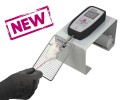Authors
Jeong JW, Shim JJ, Choi ID, Kim SH, Ra J, Ku HK, Lee DE, Kim TY, Jeung W, Lee JH, Lee KW, Huh CS, Sim JH, Ahn YT
Lab
R&BD Center, Korea Yakult Co, Ltd. , Yongin, Republic of Korea.
Journal
J Med Food.
Abstract
Ursolic acid is a lipophilic pentacyclic triterpenoid found in many fruits and herbs and is used in several herbal folk medicines for diabetes. In this study, we evaluated the effects of apple pomace extract (APE; ursolic acid content, 183?mg/g) on skeletal muscle atrophy. To examine APE therapeutic potential in muscle atrophy, we investigated APE effects on the expression of biomarkers associated with muscle atrophy and hypertrophy. We found that APE inhibited atrophy, while inducing hypertrophy in C2C12 myotubes by decreasing the expression of atrophy-related genes and increasing the expression of hypertrophy-associated genes. The in vivo experiments using mice fed a diet with or without APE showed that APE intake increased skeletal muscle mass, as well as grip strength and exercise capacity. In addition, APE significantly improved endurance in the mice, as evidenced by increased exhaustive running time and muscle weight, and reduced the expression of the genes involved in the development of muscle atrophy. APE also decreased the concentration of serum lactate and lactate dehydrogenase, inorganic phosphate, and creatinine, the indicators of accumulated fatigue and exercise-induced stress. These results suggest that APE may be useful as an ergogenic functional food or dietary supplement.
BIOSEB Instruments Used:
Grip strength test (BIO-GS3)

 Douleur - Allodynie/Hyperalgésie Thermique
Douleur - Allodynie/Hyperalgésie Thermique Douleur - Spontanée - Déficit de Posture
Douleur - Spontanée - Déficit de Posture Douleur - Allodynie/Hyperalgésie Mécanique
Douleur - Allodynie/Hyperalgésie Mécanique Apprentissage/Mémoire - Attention - Addiction
Apprentissage/Mémoire - Attention - Addiction Physiologie & Recherche Respiratoire
Physiologie & Recherche Respiratoire
 Douleur
Douleur Système Nerveux Central (SNC)
Système Nerveux Central (SNC)  Neurodégénérescence
Neurodégénérescence Système sensoriel
Système sensoriel Système moteur
Système moteur Troubles de l'humeur
Troubles de l'humeur Autres pathologies
Autres pathologies Système musculaire
Système musculaire Articulations
Articulations Métabolisme
Métabolisme Thématiques transversales
Thématiques transversales SFN2024: Venez rencontrer notre équipe sur le stand 876 à Chicago
SFN2024: Venez rencontrer notre équipe sur le stand 876 à Chicago 